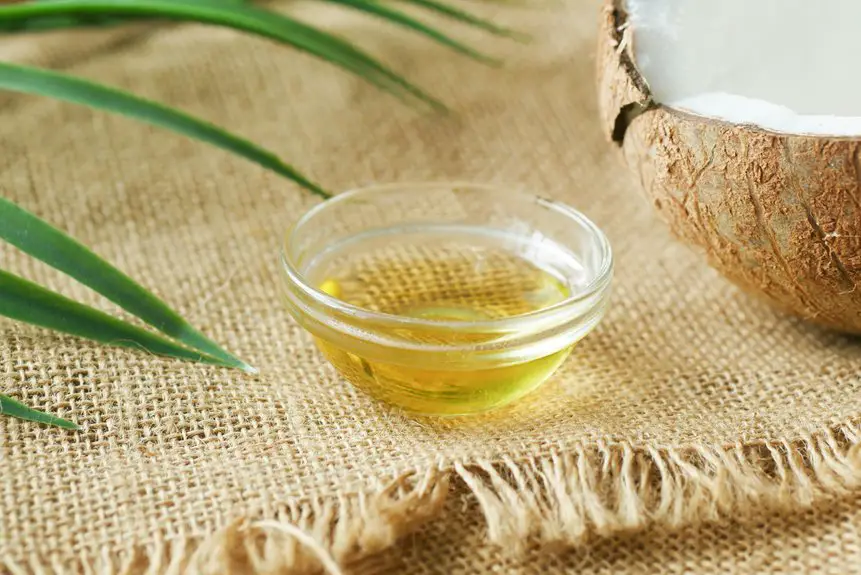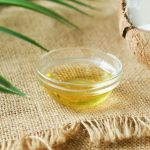When getting coconut oil out of fabric, avoid using cold water first—hot water loosens the grease better. Don’t scrub too hard, or you’ll push the oil deeper and risk damaging fibers. Skip harsh cleaners like bleach; mild dish soap works best. Never ignore the stain—pre-treat it before washing and don’t dry the fabric until the stain’s gone, or it’ll set permanently. Keep these tips in mind to make cleanup easier and more effective. Explore further to find out how.
Table of Contents
Key Takeaways
- Avoid soaking fabric in cold water first; hot water loosens coconut oil more effectively without damaging fibers.
- Do not rub the stain vigorously to prevent pushing oil deeper and damaging fabric texture.
- Use mild liquid dish soap instead of bleach or harsh detergents that harm fabric fibers.
- Always pre-treat the stain by blotting excess oil and applying soap before washing to prevent embedding.
- Never dry fabric before fully removing the stain to avoid permanently setting the oil with heat.
Using Hot Water Before Treating the Stain
Before you apply any stain remover, soak the fabric in hot water for at least 10 minutes. This step helps loosen the coconut oil, making it easier to eliminate. You want the water hot enough to break down the grease but not so hot that it damages the fabric.
Submerge the stained area fully, allowing the heat to penetrate and soften the oily residue. After soaking, gently blot the fabric with a clean cloth to absorb any oil that’s lifted to the surface. This prepares the stain for more effective treatment.
Skipping this step often leads to stubborn stains that resist cleaning. Soaking first gives you a head start, reducing the amount of scrubbing or harsh chemicals you’ll need later on. It’s a simple, effective move you won’t want to miss.
Rubbing the Stain Too Vigorously
Although you might think scrubbing the stain hard will get rid of the coconut oil faster, rubbing too vigorously can actually push the oil deeper into the fabric fibers. This makes the stain harder to remove and risks damaging the fabric’s texture. Instead, gently blot or dab the area to lift the oil without spreading it.
| Mistake | Effect | Better Approach |
|---|---|---|
| Rubbing too hard | Drives oil deeper | Dab gently |
| Using rough cloth | Wears fabric down | Use soft cloth |
| Ignoring fabric type | Causes damage | Check care instructions |
Be patient and let cleaning agents work gradually for best results.
Applying the Wrong Cleaning Products
Gentle blotting helps prevent pushing coconut oil deeper into fabric, but the cleaning products you choose matter just as much.
Avoid using bleach or harsh detergents, as they can damage the fabric fibers or set the stain permanently. Instead, opt for a mild liquid dish soap that effectively breaks down oils without harming the material.
You might be tempted to use stain removers designed for protein-based stains like blood, but these won’t work well on oil-based marks like coconut oil.
Also, steer clear of fabric softeners during the cleaning process because they can trap the oil inside the fabric.
Ignoring the Stain Before Washing
If you ignore a coconut oil stain and toss the fabric into the wash, the oil will likely set deeper into the fibers. This makes removal much harder later on. You should always pre-treat the stain before washing to increase your chances of success. Here’s what you should and shouldn’t do before washing:
| What to Do | What to Avoid |
|---|---|
| Blot excess oil gently | Rubbing stain harshly |
| Apply dish soap or stain remover | Washing without treatment |
| Let treatment sit 10–15 min | Ignoring stain completely |
| Use cold water for pre-rinse | Using hot water immediately |
| Check stain before drying | Putting fabric in dryer |
Addressing the stain early prevents it from embedding permanently and saves you from extra effort later.
Drying the Fabric Before the Stain Is Fully Removed
When you dry fabric before fully removing a coconut oil stain, you risk setting the oil permanently into the fibers.
Heat from a dryer or direct sunlight causes the oil to bond tightly, making it nearly impossible to remove later. Always check the stain after washing—if it’s still visible, avoid drying.
Heat sets oil stains permanently—always check before drying to avoid making them impossible to remove.
Instead, repeat the stain removal process using dish soap or stain remover to break down the oil further. Only once the stain is completely gone should you dry the fabric as usual.
Taking this extra step saves you from frustration and preserves your clothes. Remember, patience here pays off. Don’t rush to dry; drying too soon turns a fixable stain into a stubborn, permanent mark.
Frequently Asked Questions
Can Coconut Oil Damage All Types of Fabric Fibers?
Coconut oil can stain fabric like a stubborn ink blot. While it doesn’t usually damage fibers, it can leave greasy marks. You’ll want to treat delicate fabrics carefully to avoid weakening or discoloring them.
Is It Safe to Use Bleach on Coconut Oil Stains?
You shouldn’t use bleach on coconut oil stains because it can damage or discolor many fabrics. Instead, spot-treat with dish soap or a gentle stain remover to break down the oil without risking fabric damage.
How Long Does It Take for Coconut Oil Stains to Set?
Coconut oil stains can start setting within minutes, but they usually fully set in a few hours if untreated. To prevent permanent marks, you should treat the fabric as soon as you notice the stain.
Can Professional Dry Cleaning Remove Coconut Oil Stains?
Yes, professional dry cleaning can remove coconut oil stains effectively. They’ll use specialized solvents that break down the oil, so don’t worry if home treatments haven’t worked. Just make sure to act quickly for best results.
Are Natural Remedies Effective for Coconut Oil Stain Removal?
Of course, natural remedies are miracle workers—if you have all day and patience to spare. You’ll find they can help, but stubborn coconut oil stains often need stronger treatments to vanish completely from your fabric.
- Jaclyn Smith Fabric Coconut: a Review of This Rayon/Polyester Blend - June 29, 2025
- Jaclyn Smith Fabric Coconut: a Review of This Rayon/Polyester Blend - June 29, 2025
- How to Get Coconut Oil off Fabric Without Washing - June 29, 2025







